Financial Reporting Analysis: AASB 15, IFRS 15, and Exposure Draft
VerifiedAdded on 2023/01/18
|12
|3461
|38
Report
AI Summary
This report provides a detailed analysis of the accounting standards IFRS 15 and AASB 15, focusing on revenue recognition and the impact of the new standards on financial reporting. The report examines the key issues discussed in a news article by KPMG Australia, including the transition approaches and disclosure requirements for companies. It applies relevant theoretical frameworks, such as the conceptual accounting framework, to evaluate these issues. The report also analyzes an exposure draft related to onerous contracts and the application of public interest theory to explain the behavior of regulators. Furthermore, it outlines the views presented in comment letters regarding the exposure draft, highlighting areas of agreement and disagreement. The analysis covers the implications of the standards, transition approaches, and the five-step model for revenue recognition, providing a comprehensive overview of the changes in financial reporting. The report concludes by summarizing the key findings and emphasizing the importance of understanding and implementing these new standards.
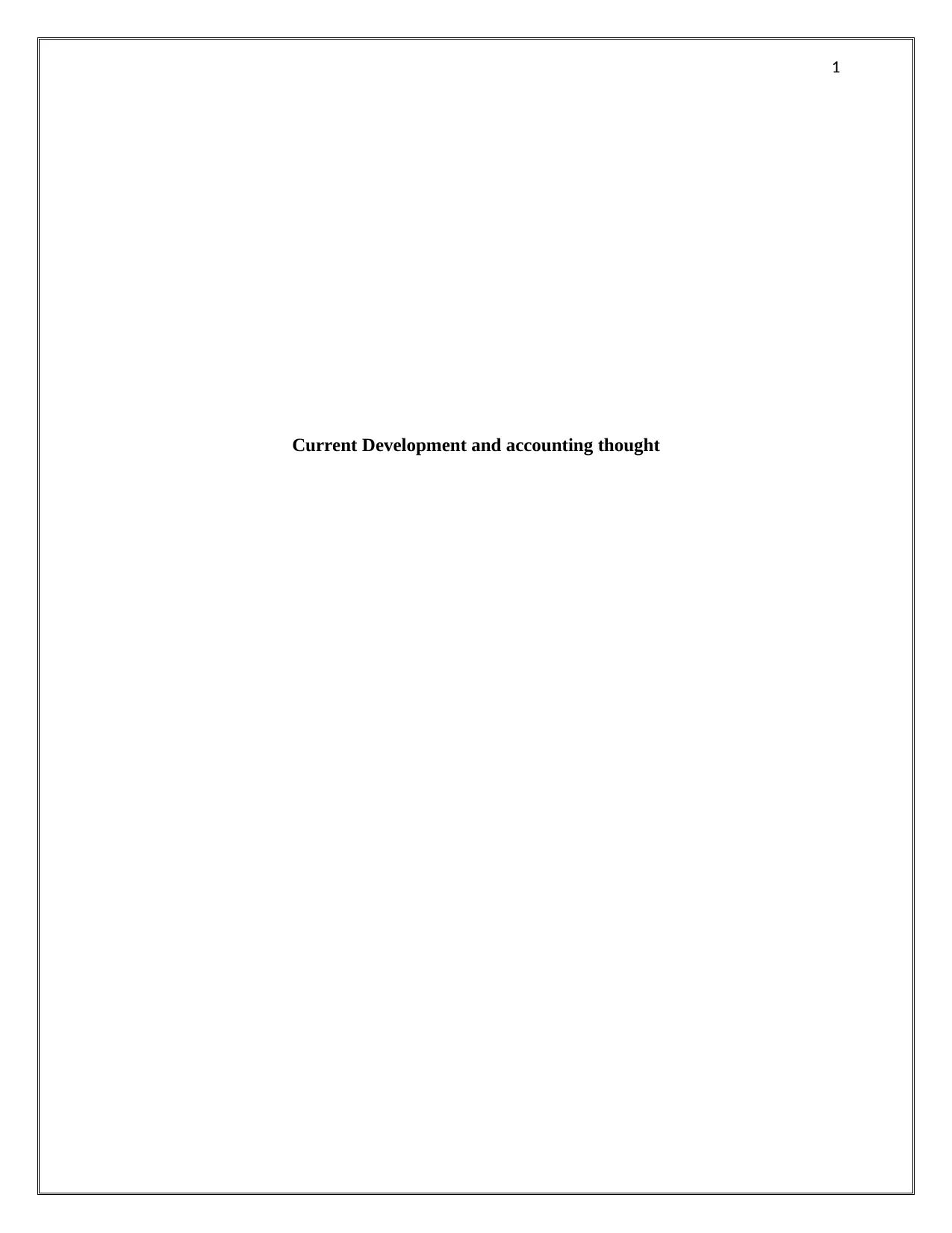
1
Current Development and accounting thought
Current Development and accounting thought
Paraphrase This Document
Need a fresh take? Get an instant paraphrase of this document with our AI Paraphraser
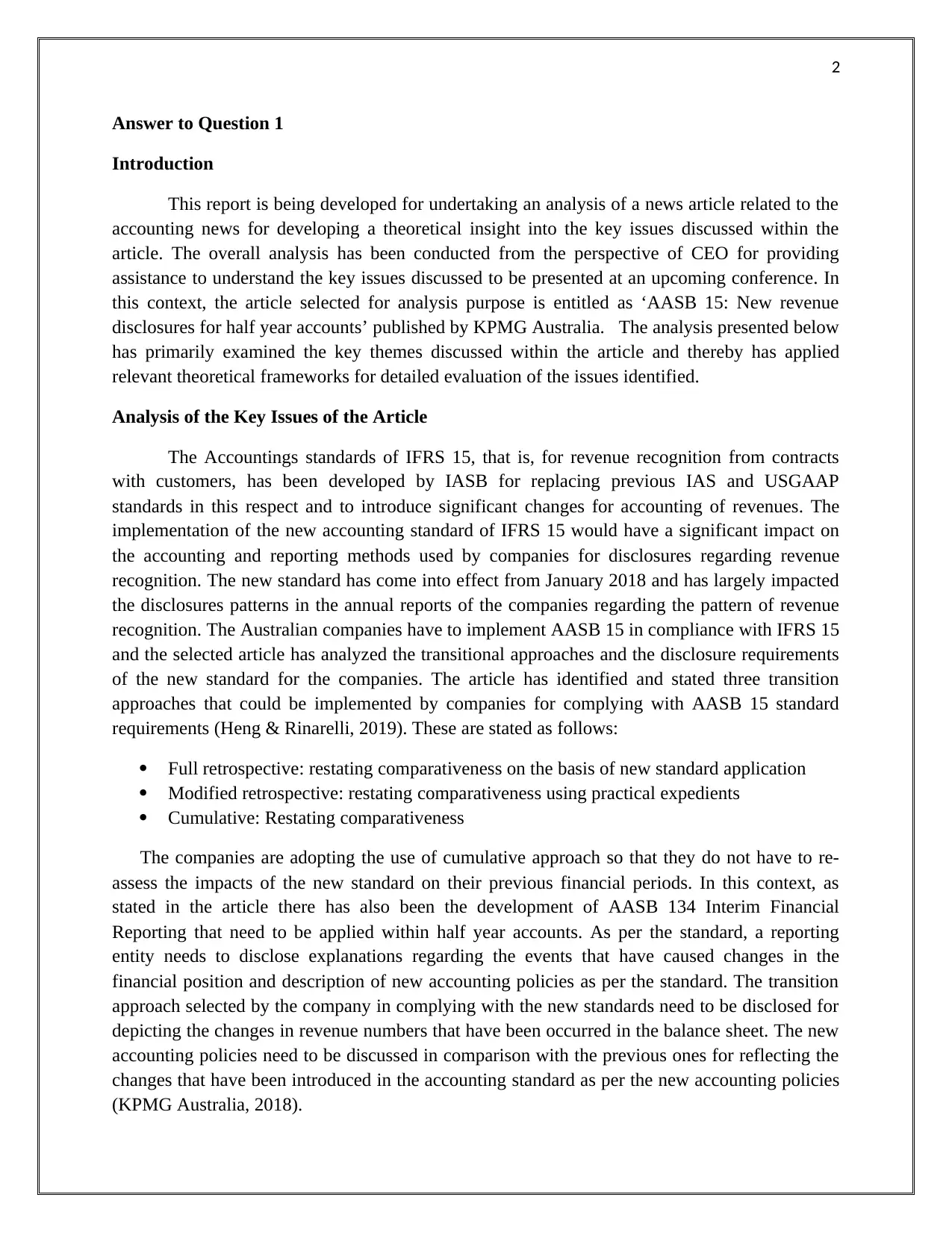
2
Answer to Question 1
Introduction
This report is being developed for undertaking an analysis of a news article related to the
accounting news for developing a theoretical insight into the key issues discussed within the
article. The overall analysis has been conducted from the perspective of CEO for providing
assistance to understand the key issues discussed to be presented at an upcoming conference. In
this context, the article selected for analysis purpose is entitled as ‘AASB 15: New revenue
disclosures for half year accounts’ published by KPMG Australia. The analysis presented below
has primarily examined the key themes discussed within the article and thereby has applied
relevant theoretical frameworks for detailed evaluation of the issues identified.
Analysis of the Key Issues of the Article
The Accountings standards of IFRS 15, that is, for revenue recognition from contracts
with customers, has been developed by IASB for replacing previous IAS and USGAAP
standards in this respect and to introduce significant changes for accounting of revenues. The
implementation of the new accounting standard of IFRS 15 would have a significant impact on
the accounting and reporting methods used by companies for disclosures regarding revenue
recognition. The new standard has come into effect from January 2018 and has largely impacted
the disclosures patterns in the annual reports of the companies regarding the pattern of revenue
recognition. The Australian companies have to implement AASB 15 in compliance with IFRS 15
and the selected article has analyzed the transitional approaches and the disclosure requirements
of the new standard for the companies. The article has identified and stated three transition
approaches that could be implemented by companies for complying with AASB 15 standard
requirements (Heng & Rinarelli, 2019). These are stated as follows:
Full retrospective: restating comparativeness on the basis of new standard application
Modified retrospective: restating comparativeness using practical expedients
Cumulative: Restating comparativeness
The companies are adopting the use of cumulative approach so that they do not have to re-
assess the impacts of the new standard on their previous financial periods. In this context, as
stated in the article there has also been the development of AASB 134 Interim Financial
Reporting that need to be applied within half year accounts. As per the standard, a reporting
entity needs to disclose explanations regarding the events that have caused changes in the
financial position and description of new accounting policies as per the standard. The transition
approach selected by the company in complying with the new standards need to be disclosed for
depicting the changes in revenue numbers that have been occurred in the balance sheet. The new
accounting policies need to be discussed in comparison with the previous ones for reflecting the
changes that have been introduced in the accounting standard as per the new accounting policies
(KPMG Australia, 2018).
Answer to Question 1
Introduction
This report is being developed for undertaking an analysis of a news article related to the
accounting news for developing a theoretical insight into the key issues discussed within the
article. The overall analysis has been conducted from the perspective of CEO for providing
assistance to understand the key issues discussed to be presented at an upcoming conference. In
this context, the article selected for analysis purpose is entitled as ‘AASB 15: New revenue
disclosures for half year accounts’ published by KPMG Australia. The analysis presented below
has primarily examined the key themes discussed within the article and thereby has applied
relevant theoretical frameworks for detailed evaluation of the issues identified.
Analysis of the Key Issues of the Article
The Accountings standards of IFRS 15, that is, for revenue recognition from contracts
with customers, has been developed by IASB for replacing previous IAS and USGAAP
standards in this respect and to introduce significant changes for accounting of revenues. The
implementation of the new accounting standard of IFRS 15 would have a significant impact on
the accounting and reporting methods used by companies for disclosures regarding revenue
recognition. The new standard has come into effect from January 2018 and has largely impacted
the disclosures patterns in the annual reports of the companies regarding the pattern of revenue
recognition. The Australian companies have to implement AASB 15 in compliance with IFRS 15
and the selected article has analyzed the transitional approaches and the disclosure requirements
of the new standard for the companies. The article has identified and stated three transition
approaches that could be implemented by companies for complying with AASB 15 standard
requirements (Heng & Rinarelli, 2019). These are stated as follows:
Full retrospective: restating comparativeness on the basis of new standard application
Modified retrospective: restating comparativeness using practical expedients
Cumulative: Restating comparativeness
The companies are adopting the use of cumulative approach so that they do not have to re-
assess the impacts of the new standard on their previous financial periods. In this context, as
stated in the article there has also been the development of AASB 134 Interim Financial
Reporting that need to be applied within half year accounts. As per the standard, a reporting
entity needs to disclose explanations regarding the events that have caused changes in the
financial position and description of new accounting policies as per the standard. The transition
approach selected by the company in complying with the new standards need to be disclosed for
depicting the changes in revenue numbers that have been occurred in the balance sheet. The new
accounting policies need to be discussed in comparison with the previous ones for reflecting the
changes that have been introduced in the accounting standard as per the new accounting policies
(KPMG Australia, 2018).
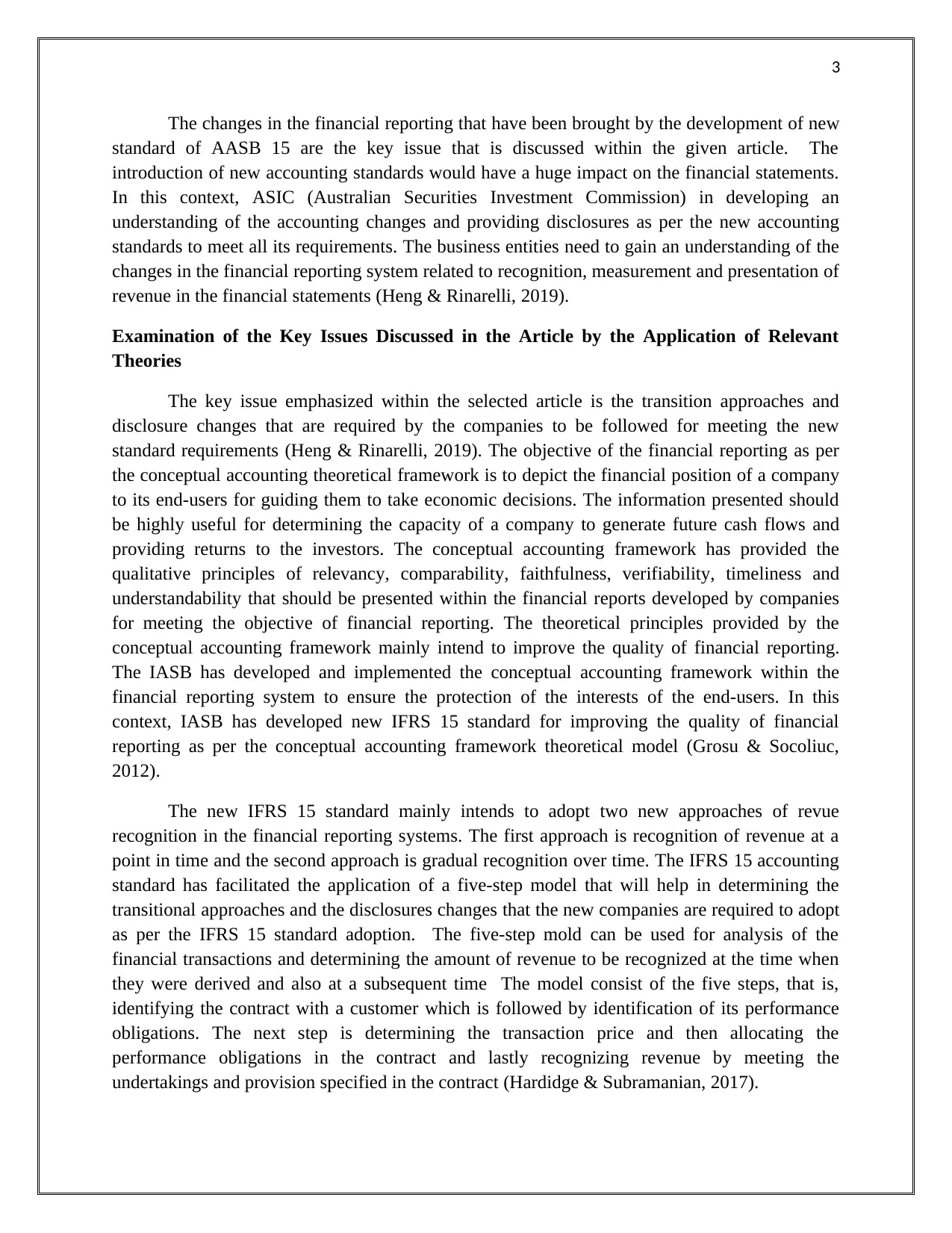
3
The changes in the financial reporting that have been brought by the development of new
standard of AASB 15 are the key issue that is discussed within the given article. The
introduction of new accounting standards would have a huge impact on the financial statements.
In this context, ASIC (Australian Securities Investment Commission) in developing an
understanding of the accounting changes and providing disclosures as per the new accounting
standards to meet all its requirements. The business entities need to gain an understanding of the
changes in the financial reporting system related to recognition, measurement and presentation of
revenue in the financial statements (Heng & Rinarelli, 2019).
Examination of the Key Issues Discussed in the Article by the Application of Relevant
Theories
The key issue emphasized within the selected article is the transition approaches and
disclosure changes that are required by the companies to be followed for meeting the new
standard requirements (Heng & Rinarelli, 2019). The objective of the financial reporting as per
the conceptual accounting theoretical framework is to depict the financial position of a company
to its end-users for guiding them to take economic decisions. The information presented should
be highly useful for determining the capacity of a company to generate future cash flows and
providing returns to the investors. The conceptual accounting framework has provided the
qualitative principles of relevancy, comparability, faithfulness, verifiability, timeliness and
understandability that should be presented within the financial reports developed by companies
for meeting the objective of financial reporting. The theoretical principles provided by the
conceptual accounting framework mainly intend to improve the quality of financial reporting.
The IASB has developed and implemented the conceptual accounting framework within the
financial reporting system to ensure the protection of the interests of the end-users. In this
context, IASB has developed new IFRS 15 standard for improving the quality of financial
reporting as per the conceptual accounting framework theoretical model (Grosu & Socoliuc,
2012).
The new IFRS 15 standard mainly intends to adopt two new approaches of revue
recognition in the financial reporting systems. The first approach is recognition of revenue at a
point in time and the second approach is gradual recognition over time. The IFRS 15 accounting
standard has facilitated the application of a five-step model that will help in determining the
transitional approaches and the disclosures changes that the new companies are required to adopt
as per the IFRS 15 standard adoption. The five-step mold can be used for analysis of the
financial transactions and determining the amount of revenue to be recognized at the time when
they were derived and also at a subsequent time The model consist of the five steps, that is,
identifying the contract with a customer which is followed by identification of its performance
obligations. The next step is determining the transaction price and then allocating the
performance obligations in the contract and lastly recognizing revenue by meeting the
undertakings and provision specified in the contract (Hardidge & Subramanian, 2017).
The changes in the financial reporting that have been brought by the development of new
standard of AASB 15 are the key issue that is discussed within the given article. The
introduction of new accounting standards would have a huge impact on the financial statements.
In this context, ASIC (Australian Securities Investment Commission) in developing an
understanding of the accounting changes and providing disclosures as per the new accounting
standards to meet all its requirements. The business entities need to gain an understanding of the
changes in the financial reporting system related to recognition, measurement and presentation of
revenue in the financial statements (Heng & Rinarelli, 2019).
Examination of the Key Issues Discussed in the Article by the Application of Relevant
Theories
The key issue emphasized within the selected article is the transition approaches and
disclosure changes that are required by the companies to be followed for meeting the new
standard requirements (Heng & Rinarelli, 2019). The objective of the financial reporting as per
the conceptual accounting theoretical framework is to depict the financial position of a company
to its end-users for guiding them to take economic decisions. The information presented should
be highly useful for determining the capacity of a company to generate future cash flows and
providing returns to the investors. The conceptual accounting framework has provided the
qualitative principles of relevancy, comparability, faithfulness, verifiability, timeliness and
understandability that should be presented within the financial reports developed by companies
for meeting the objective of financial reporting. The theoretical principles provided by the
conceptual accounting framework mainly intend to improve the quality of financial reporting.
The IASB has developed and implemented the conceptual accounting framework within the
financial reporting system to ensure the protection of the interests of the end-users. In this
context, IASB has developed new IFRS 15 standard for improving the quality of financial
reporting as per the conceptual accounting framework theoretical model (Grosu & Socoliuc,
2012).
The new IFRS 15 standard mainly intends to adopt two new approaches of revue
recognition in the financial reporting systems. The first approach is recognition of revenue at a
point in time and the second approach is gradual recognition over time. The IFRS 15 accounting
standard has facilitated the application of a five-step model that will help in determining the
transitional approaches and the disclosures changes that the new companies are required to adopt
as per the IFRS 15 standard adoption. The five-step mold can be used for analysis of the
financial transactions and determining the amount of revenue to be recognized at the time when
they were derived and also at a subsequent time The model consist of the five steps, that is,
identifying the contract with a customer which is followed by identification of its performance
obligations. The next step is determining the transaction price and then allocating the
performance obligations in the contract and lastly recognizing revenue by meeting the
undertakings and provision specified in the contract (Hardidge & Subramanian, 2017).
⊘ This is a preview!⊘
Do you want full access?
Subscribe today to unlock all pages.

Trusted by 1+ million students worldwide
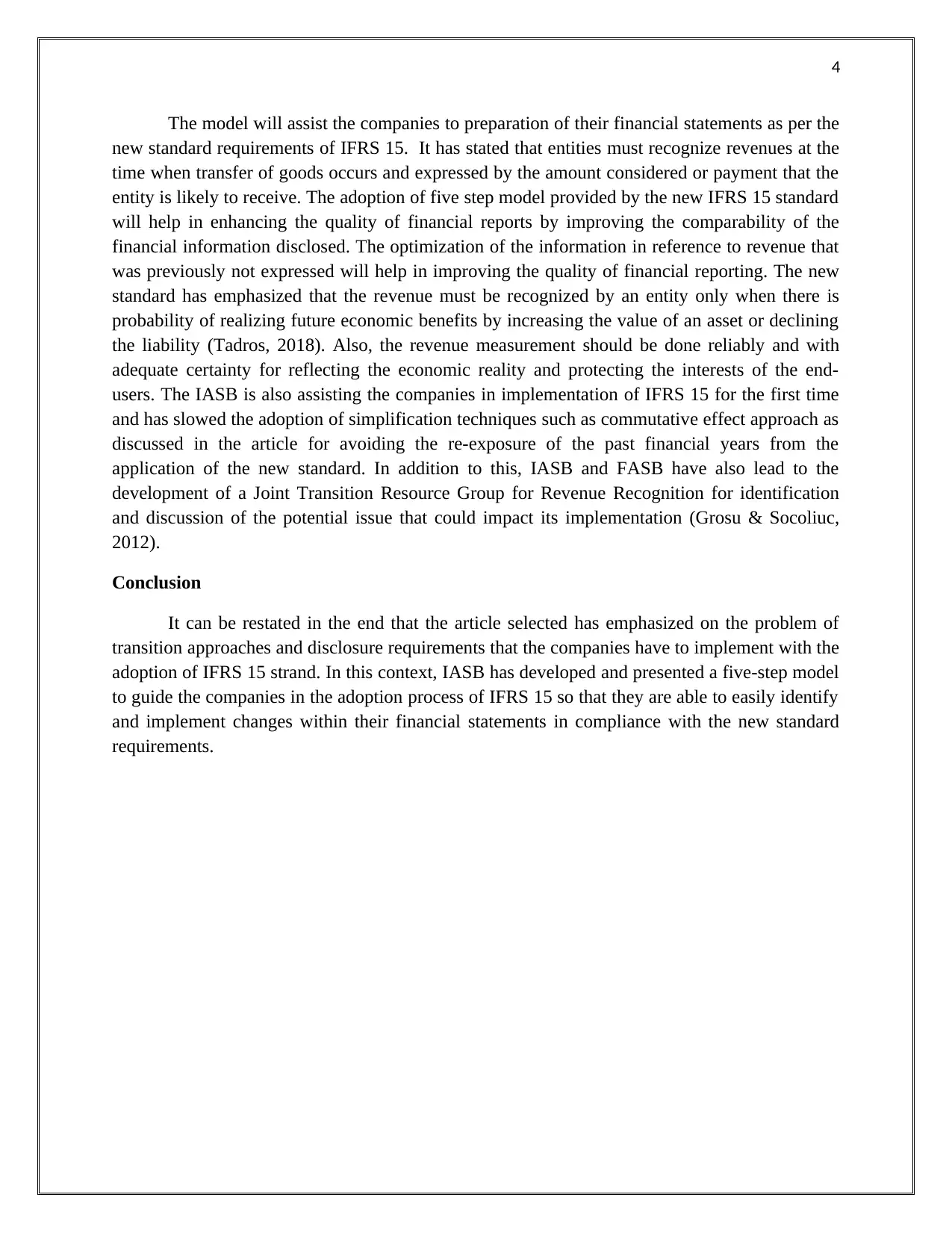
4
The model will assist the companies to preparation of their financial statements as per the
new standard requirements of IFRS 15. It has stated that entities must recognize revenues at the
time when transfer of goods occurs and expressed by the amount considered or payment that the
entity is likely to receive. The adoption of five step model provided by the new IFRS 15 standard
will help in enhancing the quality of financial reports by improving the comparability of the
financial information disclosed. The optimization of the information in reference to revenue that
was previously not expressed will help in improving the quality of financial reporting. The new
standard has emphasized that the revenue must be recognized by an entity only when there is
probability of realizing future economic benefits by increasing the value of an asset or declining
the liability (Tadros, 2018). Also, the revenue measurement should be done reliably and with
adequate certainty for reflecting the economic reality and protecting the interests of the end-
users. The IASB is also assisting the companies in implementation of IFRS 15 for the first time
and has slowed the adoption of simplification techniques such as commutative effect approach as
discussed in the article for avoiding the re-exposure of the past financial years from the
application of the new standard. In addition to this, IASB and FASB have also lead to the
development of a Joint Transition Resource Group for Revenue Recognition for identification
and discussion of the potential issue that could impact its implementation (Grosu & Socoliuc,
2012).
Conclusion
It can be restated in the end that the article selected has emphasized on the problem of
transition approaches and disclosure requirements that the companies have to implement with the
adoption of IFRS 15 strand. In this context, IASB has developed and presented a five-step model
to guide the companies in the adoption process of IFRS 15 so that they are able to easily identify
and implement changes within their financial statements in compliance with the new standard
requirements.
The model will assist the companies to preparation of their financial statements as per the
new standard requirements of IFRS 15. It has stated that entities must recognize revenues at the
time when transfer of goods occurs and expressed by the amount considered or payment that the
entity is likely to receive. The adoption of five step model provided by the new IFRS 15 standard
will help in enhancing the quality of financial reports by improving the comparability of the
financial information disclosed. The optimization of the information in reference to revenue that
was previously not expressed will help in improving the quality of financial reporting. The new
standard has emphasized that the revenue must be recognized by an entity only when there is
probability of realizing future economic benefits by increasing the value of an asset or declining
the liability (Tadros, 2018). Also, the revenue measurement should be done reliably and with
adequate certainty for reflecting the economic reality and protecting the interests of the end-
users. The IASB is also assisting the companies in implementation of IFRS 15 for the first time
and has slowed the adoption of simplification techniques such as commutative effect approach as
discussed in the article for avoiding the re-exposure of the past financial years from the
application of the new standard. In addition to this, IASB and FASB have also lead to the
development of a Joint Transition Resource Group for Revenue Recognition for identification
and discussion of the potential issue that could impact its implementation (Grosu & Socoliuc,
2012).
Conclusion
It can be restated in the end that the article selected has emphasized on the problem of
transition approaches and disclosure requirements that the companies have to implement with the
adoption of IFRS 15 strand. In this context, IASB has developed and presented a five-step model
to guide the companies in the adoption process of IFRS 15 so that they are able to easily identify
and implement changes within their financial statements in compliance with the new standard
requirements.
Paraphrase This Document
Need a fresh take? Get an instant paraphrase of this document with our AI Paraphraser
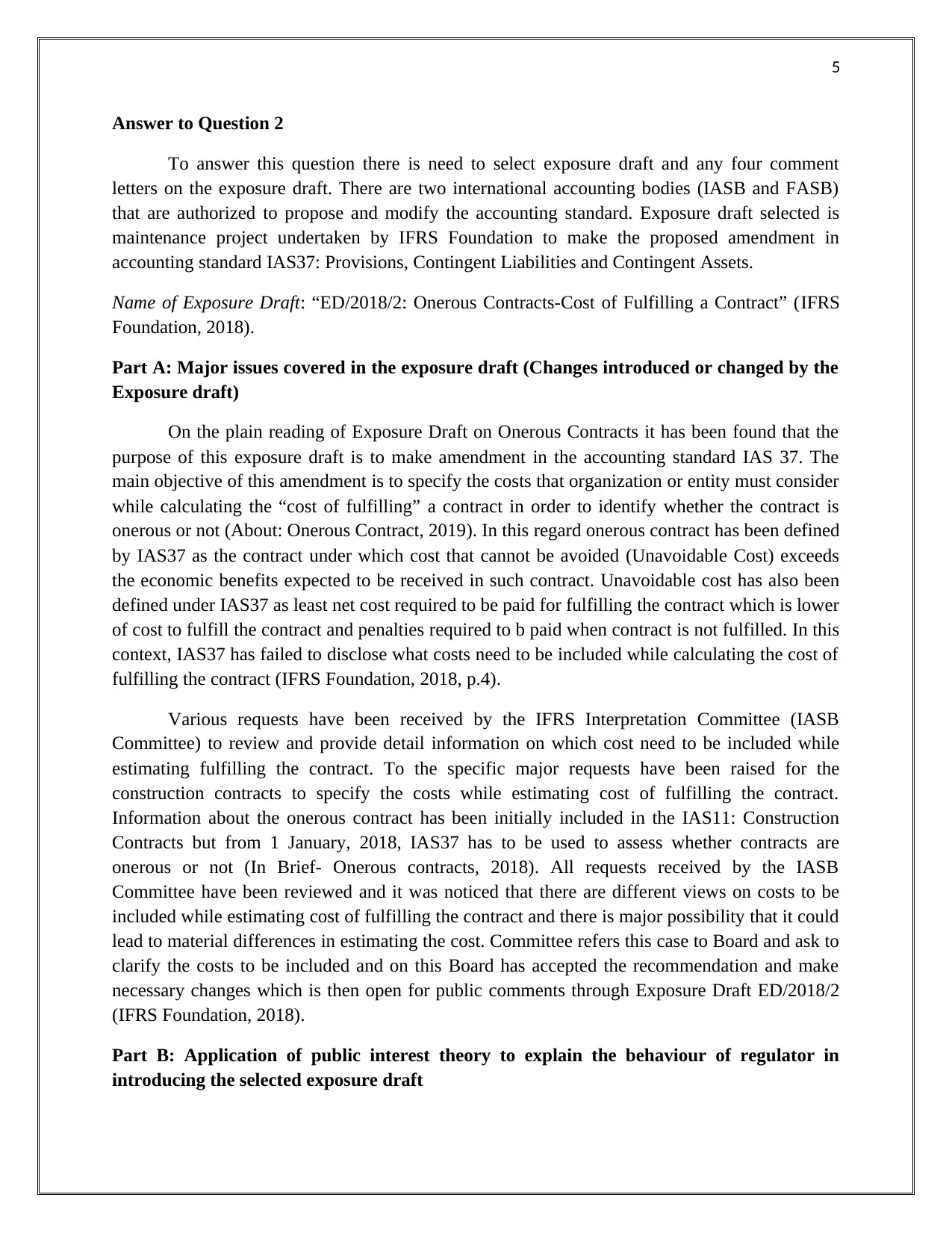
5
Answer to Question 2
To answer this question there is need to select exposure draft and any four comment
letters on the exposure draft. There are two international accounting bodies (IASB and FASB)
that are authorized to propose and modify the accounting standard. Exposure draft selected is
maintenance project undertaken by IFRS Foundation to make the proposed amendment in
accounting standard IAS37: Provisions, Contingent Liabilities and Contingent Assets.
Name of Exposure Draft: “ED/2018/2: Onerous Contracts-Cost of Fulfilling a Contract” (IFRS
Foundation, 2018).
Part A: Major issues covered in the exposure draft (Changes introduced or changed by the
Exposure draft)
On the plain reading of Exposure Draft on Onerous Contracts it has been found that the
purpose of this exposure draft is to make amendment in the accounting standard IAS 37. The
main objective of this amendment is to specify the costs that organization or entity must consider
while calculating the “cost of fulfilling” a contract in order to identify whether the contract is
onerous or not (About: Onerous Contract, 2019). In this regard onerous contract has been defined
by IAS37 as the contract under which cost that cannot be avoided (Unavoidable Cost) exceeds
the economic benefits expected to be received in such contract. Unavoidable cost has also been
defined under IAS37 as least net cost required to be paid for fulfilling the contract which is lower
of cost to fulfill the contract and penalties required to b paid when contract is not fulfilled. In this
context, IAS37 has failed to disclose what costs need to be included while calculating the cost of
fulfilling the contract (IFRS Foundation, 2018, p.4).
Various requests have been received by the IFRS Interpretation Committee (IASB
Committee) to review and provide detail information on which cost need to be included while
estimating fulfilling the contract. To the specific major requests have been raised for the
construction contracts to specify the costs while estimating cost of fulfilling the contract.
Information about the onerous contract has been initially included in the IAS11: Construction
Contracts but from 1 January, 2018, IAS37 has to be used to assess whether contracts are
onerous or not (In Brief- Onerous contracts, 2018). All requests received by the IASB
Committee have been reviewed and it was noticed that there are different views on costs to be
included while estimating cost of fulfilling the contract and there is major possibility that it could
lead to material differences in estimating the cost. Committee refers this case to Board and ask to
clarify the costs to be included and on this Board has accepted the recommendation and make
necessary changes which is then open for public comments through Exposure Draft ED/2018/2
(IFRS Foundation, 2018).
Part B: Application of public interest theory to explain the behaviour of regulator in
introducing the selected exposure draft
Answer to Question 2
To answer this question there is need to select exposure draft and any four comment
letters on the exposure draft. There are two international accounting bodies (IASB and FASB)
that are authorized to propose and modify the accounting standard. Exposure draft selected is
maintenance project undertaken by IFRS Foundation to make the proposed amendment in
accounting standard IAS37: Provisions, Contingent Liabilities and Contingent Assets.
Name of Exposure Draft: “ED/2018/2: Onerous Contracts-Cost of Fulfilling a Contract” (IFRS
Foundation, 2018).
Part A: Major issues covered in the exposure draft (Changes introduced or changed by the
Exposure draft)
On the plain reading of Exposure Draft on Onerous Contracts it has been found that the
purpose of this exposure draft is to make amendment in the accounting standard IAS 37. The
main objective of this amendment is to specify the costs that organization or entity must consider
while calculating the “cost of fulfilling” a contract in order to identify whether the contract is
onerous or not (About: Onerous Contract, 2019). In this regard onerous contract has been defined
by IAS37 as the contract under which cost that cannot be avoided (Unavoidable Cost) exceeds
the economic benefits expected to be received in such contract. Unavoidable cost has also been
defined under IAS37 as least net cost required to be paid for fulfilling the contract which is lower
of cost to fulfill the contract and penalties required to b paid when contract is not fulfilled. In this
context, IAS37 has failed to disclose what costs need to be included while calculating the cost of
fulfilling the contract (IFRS Foundation, 2018, p.4).
Various requests have been received by the IFRS Interpretation Committee (IASB
Committee) to review and provide detail information on which cost need to be included while
estimating fulfilling the contract. To the specific major requests have been raised for the
construction contracts to specify the costs while estimating cost of fulfilling the contract.
Information about the onerous contract has been initially included in the IAS11: Construction
Contracts but from 1 January, 2018, IAS37 has to be used to assess whether contracts are
onerous or not (In Brief- Onerous contracts, 2018). All requests received by the IASB
Committee have been reviewed and it was noticed that there are different views on costs to be
included while estimating cost of fulfilling the contract and there is major possibility that it could
lead to material differences in estimating the cost. Committee refers this case to Board and ask to
clarify the costs to be included and on this Board has accepted the recommendation and make
necessary changes which is then open for public comments through Exposure Draft ED/2018/2
(IFRS Foundation, 2018).
Part B: Application of public interest theory to explain the behaviour of regulator in
introducing the selected exposure draft
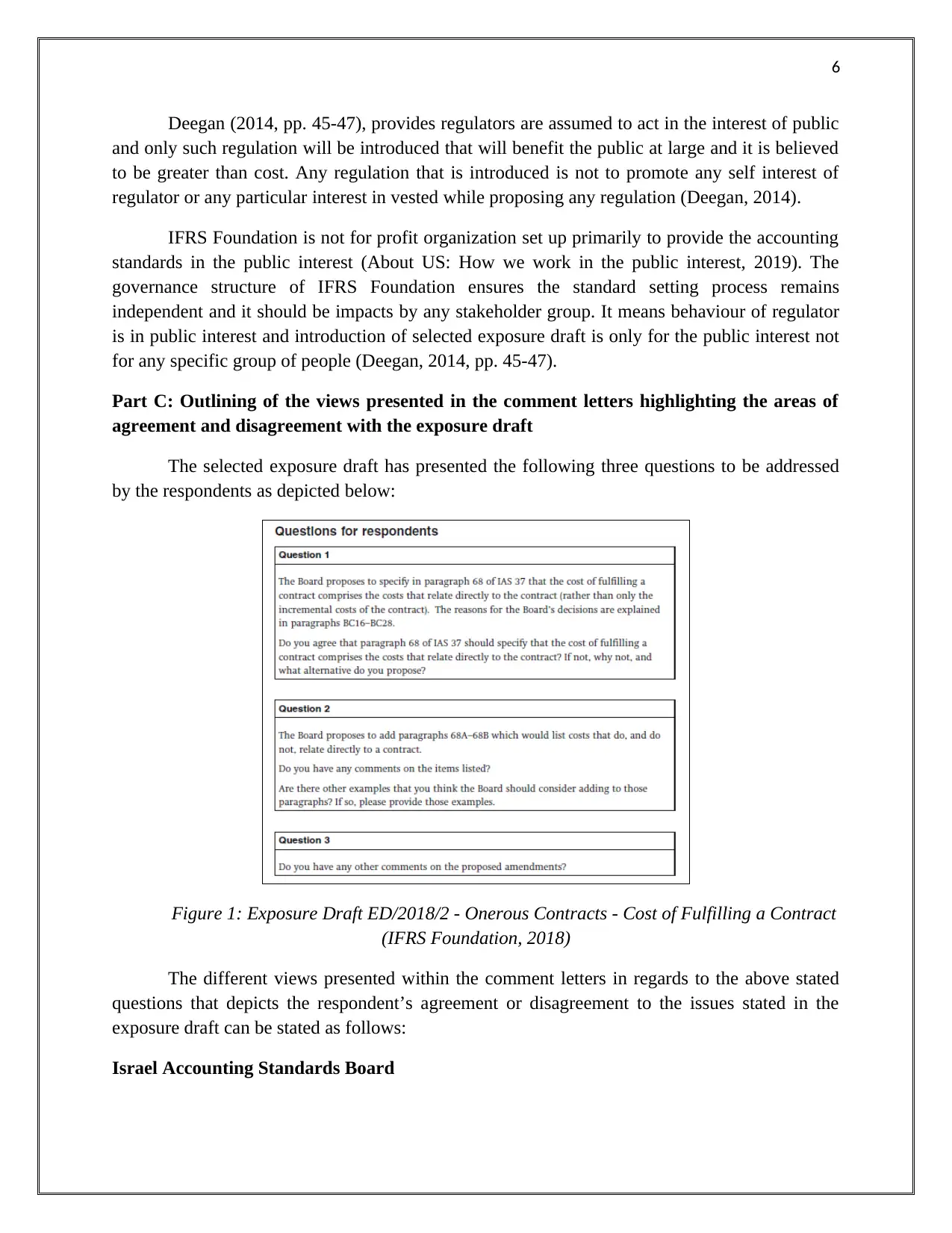
6
Deegan (2014, pp. 45-47), provides regulators are assumed to act in the interest of public
and only such regulation will be introduced that will benefit the public at large and it is believed
to be greater than cost. Any regulation that is introduced is not to promote any self interest of
regulator or any particular interest in vested while proposing any regulation (Deegan, 2014).
IFRS Foundation is not for profit organization set up primarily to provide the accounting
standards in the public interest (About US: How we work in the public interest, 2019). The
governance structure of IFRS Foundation ensures the standard setting process remains
independent and it should be impacts by any stakeholder group. It means behaviour of regulator
is in public interest and introduction of selected exposure draft is only for the public interest not
for any specific group of people (Deegan, 2014, pp. 45-47).
Part C: Outlining of the views presented in the comment letters highlighting the areas of
agreement and disagreement with the exposure draft
The selected exposure draft has presented the following three questions to be addressed
by the respondents as depicted below:
Figure 1: Exposure Draft ED/2018/2 - Onerous Contracts - Cost of Fulfilling a Contract
(IFRS Foundation, 2018)
The different views presented within the comment letters in regards to the above stated
questions that depicts the respondent’s agreement or disagreement to the issues stated in the
exposure draft can be stated as follows:
Israel Accounting Standards Board
Deegan (2014, pp. 45-47), provides regulators are assumed to act in the interest of public
and only such regulation will be introduced that will benefit the public at large and it is believed
to be greater than cost. Any regulation that is introduced is not to promote any self interest of
regulator or any particular interest in vested while proposing any regulation (Deegan, 2014).
IFRS Foundation is not for profit organization set up primarily to provide the accounting
standards in the public interest (About US: How we work in the public interest, 2019). The
governance structure of IFRS Foundation ensures the standard setting process remains
independent and it should be impacts by any stakeholder group. It means behaviour of regulator
is in public interest and introduction of selected exposure draft is only for the public interest not
for any specific group of people (Deegan, 2014, pp. 45-47).
Part C: Outlining of the views presented in the comment letters highlighting the areas of
agreement and disagreement with the exposure draft
The selected exposure draft has presented the following three questions to be addressed
by the respondents as depicted below:
Figure 1: Exposure Draft ED/2018/2 - Onerous Contracts - Cost of Fulfilling a Contract
(IFRS Foundation, 2018)
The different views presented within the comment letters in regards to the above stated
questions that depicts the respondent’s agreement or disagreement to the issues stated in the
exposure draft can be stated as follows:
Israel Accounting Standards Board
⊘ This is a preview!⊘
Do you want full access?
Subscribe today to unlock all pages.

Trusted by 1+ million students worldwide
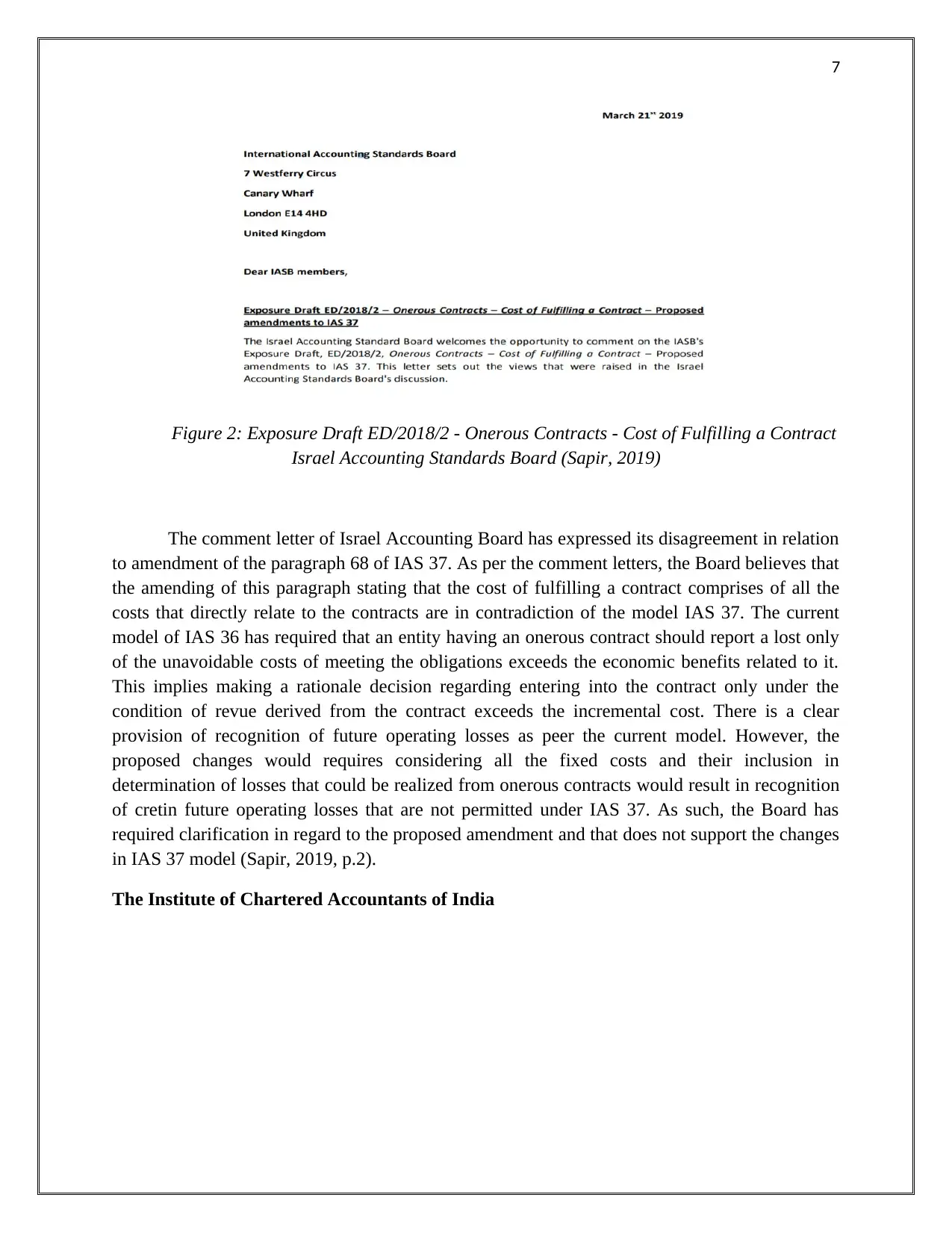
7
Figure 2: Exposure Draft ED/2018/2 - Onerous Contracts - Cost of Fulfilling a Contract
Israel Accounting Standards Board (Sapir, 2019)
The comment letter of Israel Accounting Board has expressed its disagreement in relation
to amendment of the paragraph 68 of IAS 37. As per the comment letters, the Board believes that
the amending of this paragraph stating that the cost of fulfilling a contract comprises of all the
costs that directly relate to the contracts are in contradiction of the model IAS 37. The current
model of IAS 36 has required that an entity having an onerous contract should report a lost only
of the unavoidable costs of meeting the obligations exceeds the economic benefits related to it.
This implies making a rationale decision regarding entering into the contract only under the
condition of revue derived from the contract exceeds the incremental cost. There is a clear
provision of recognition of future operating losses as peer the current model. However, the
proposed changes would requires considering all the fixed costs and their inclusion in
determination of losses that could be realized from onerous contracts would result in recognition
of cretin future operating losses that are not permitted under IAS 37. As such, the Board has
required clarification in regard to the proposed amendment and that does not support the changes
in IAS 37 model (Sapir, 2019, p.2).
The Institute of Chartered Accountants of India
Figure 2: Exposure Draft ED/2018/2 - Onerous Contracts - Cost of Fulfilling a Contract
Israel Accounting Standards Board (Sapir, 2019)
The comment letter of Israel Accounting Board has expressed its disagreement in relation
to amendment of the paragraph 68 of IAS 37. As per the comment letters, the Board believes that
the amending of this paragraph stating that the cost of fulfilling a contract comprises of all the
costs that directly relate to the contracts are in contradiction of the model IAS 37. The current
model of IAS 36 has required that an entity having an onerous contract should report a lost only
of the unavoidable costs of meeting the obligations exceeds the economic benefits related to it.
This implies making a rationale decision regarding entering into the contract only under the
condition of revue derived from the contract exceeds the incremental cost. There is a clear
provision of recognition of future operating losses as peer the current model. However, the
proposed changes would requires considering all the fixed costs and their inclusion in
determination of losses that could be realized from onerous contracts would result in recognition
of cretin future operating losses that are not permitted under IAS 37. As such, the Board has
required clarification in regard to the proposed amendment and that does not support the changes
in IAS 37 model (Sapir, 2019, p.2).
The Institute of Chartered Accountants of India
Paraphrase This Document
Need a fresh take? Get an instant paraphrase of this document with our AI Paraphraser
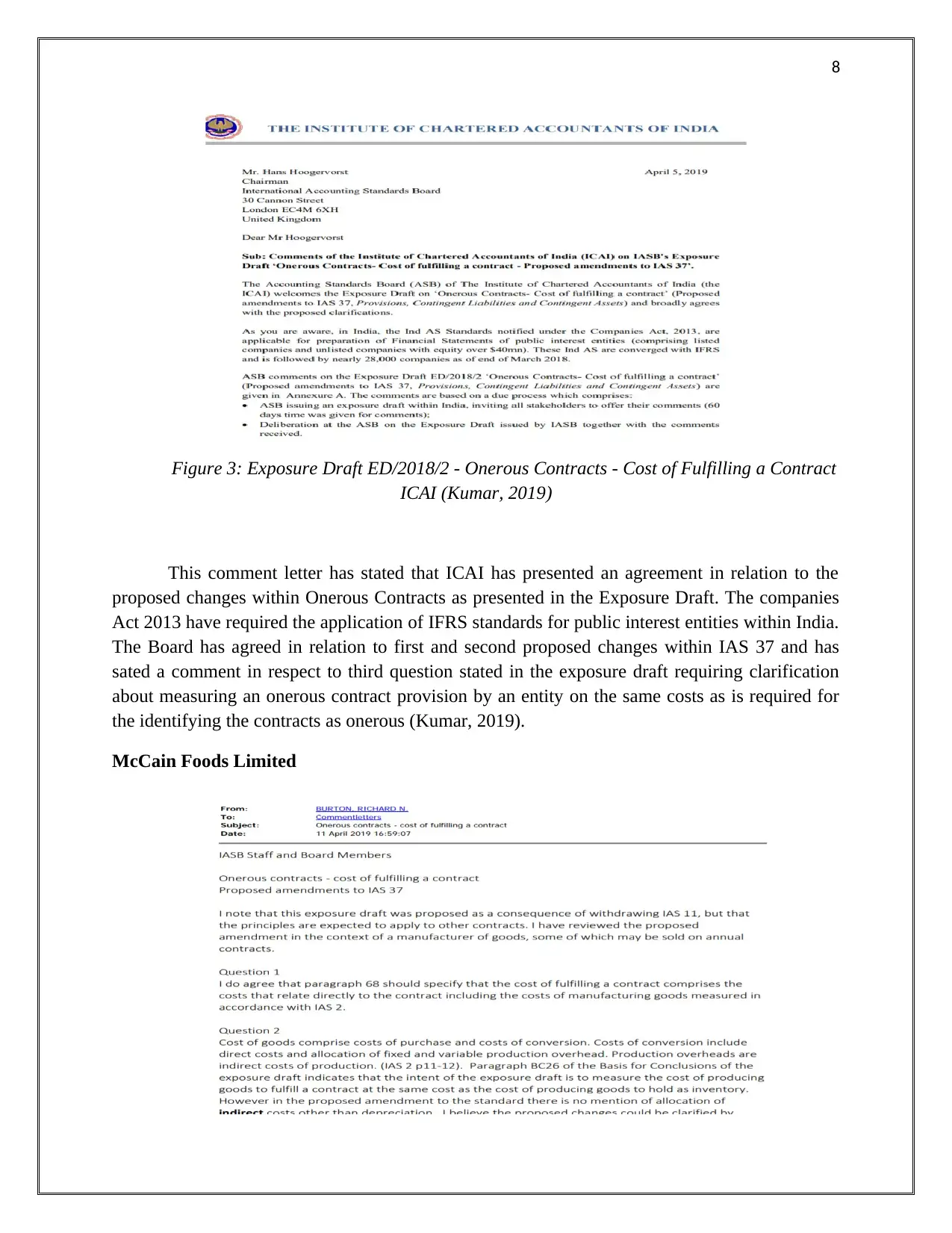
8
Figure 3: Exposure Draft ED/2018/2 - Onerous Contracts - Cost of Fulfilling a Contract
ICAI (Kumar, 2019)
This comment letter has stated that ICAI has presented an agreement in relation to the
proposed changes within Onerous Contracts as presented in the Exposure Draft. The companies
Act 2013 have required the application of IFRS standards for public interest entities within India.
The Board has agreed in relation to first and second proposed changes within IAS 37 and has
sated a comment in respect to third question stated in the exposure draft requiring clarification
about measuring an onerous contract provision by an entity on the same costs as is required for
the identifying the contracts as onerous (Kumar, 2019).
McCain Foods Limited
Figure 3: Exposure Draft ED/2018/2 - Onerous Contracts - Cost of Fulfilling a Contract
ICAI (Kumar, 2019)
This comment letter has stated that ICAI has presented an agreement in relation to the
proposed changes within Onerous Contracts as presented in the Exposure Draft. The companies
Act 2013 have required the application of IFRS standards for public interest entities within India.
The Board has agreed in relation to first and second proposed changes within IAS 37 and has
sated a comment in respect to third question stated in the exposure draft requiring clarification
about measuring an onerous contract provision by an entity on the same costs as is required for
the identifying the contracts as onerous (Kumar, 2019).
McCain Foods Limited
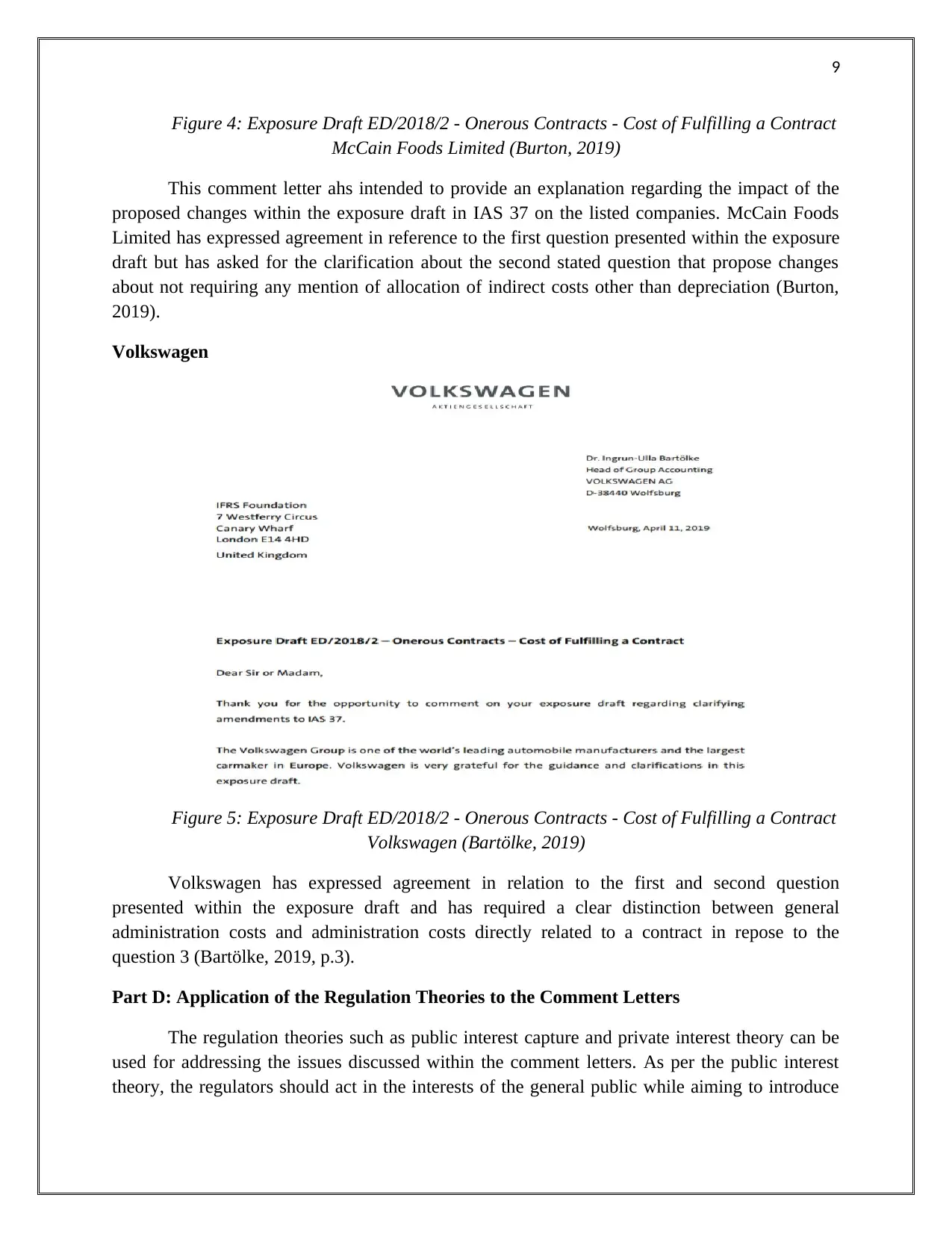
9
Figure 4: Exposure Draft ED/2018/2 - Onerous Contracts - Cost of Fulfilling a Contract
McCain Foods Limited (Burton, 2019)
This comment letter ahs intended to provide an explanation regarding the impact of the
proposed changes within the exposure draft in IAS 37 on the listed companies. McCain Foods
Limited has expressed agreement in reference to the first question presented within the exposure
draft but has asked for the clarification about the second stated question that propose changes
about not requiring any mention of allocation of indirect costs other than depreciation (Burton,
2019).
Volkswagen
Figure 5: Exposure Draft ED/2018/2 - Onerous Contracts - Cost of Fulfilling a Contract
Volkswagen (Bartölke, 2019)
Volkswagen has expressed agreement in relation to the first and second question
presented within the exposure draft and has required a clear distinction between general
administration costs and administration costs directly related to a contract in repose to the
question 3 (Bartölke, 2019, p.3).
Part D: Application of the Regulation Theories to the Comment Letters
The regulation theories such as public interest capture and private interest theory can be
used for addressing the issues discussed within the comment letters. As per the public interest
theory, the regulators should act in the interests of the general public while aiming to introduce
Figure 4: Exposure Draft ED/2018/2 - Onerous Contracts - Cost of Fulfilling a Contract
McCain Foods Limited (Burton, 2019)
This comment letter ahs intended to provide an explanation regarding the impact of the
proposed changes within the exposure draft in IAS 37 on the listed companies. McCain Foods
Limited has expressed agreement in reference to the first question presented within the exposure
draft but has asked for the clarification about the second stated question that propose changes
about not requiring any mention of allocation of indirect costs other than depreciation (Burton,
2019).
Volkswagen
Figure 5: Exposure Draft ED/2018/2 - Onerous Contracts - Cost of Fulfilling a Contract
Volkswagen (Bartölke, 2019)
Volkswagen has expressed agreement in relation to the first and second question
presented within the exposure draft and has required a clear distinction between general
administration costs and administration costs directly related to a contract in repose to the
question 3 (Bartölke, 2019, p.3).
Part D: Application of the Regulation Theories to the Comment Letters
The regulation theories such as public interest capture and private interest theory can be
used for addressing the issues discussed within the comment letters. As per the public interest
theory, the regulators should act in the interests of the general public while aiming to introduce
⊘ This is a preview!⊘
Do you want full access?
Subscribe today to unlock all pages.

Trusted by 1+ million students worldwide
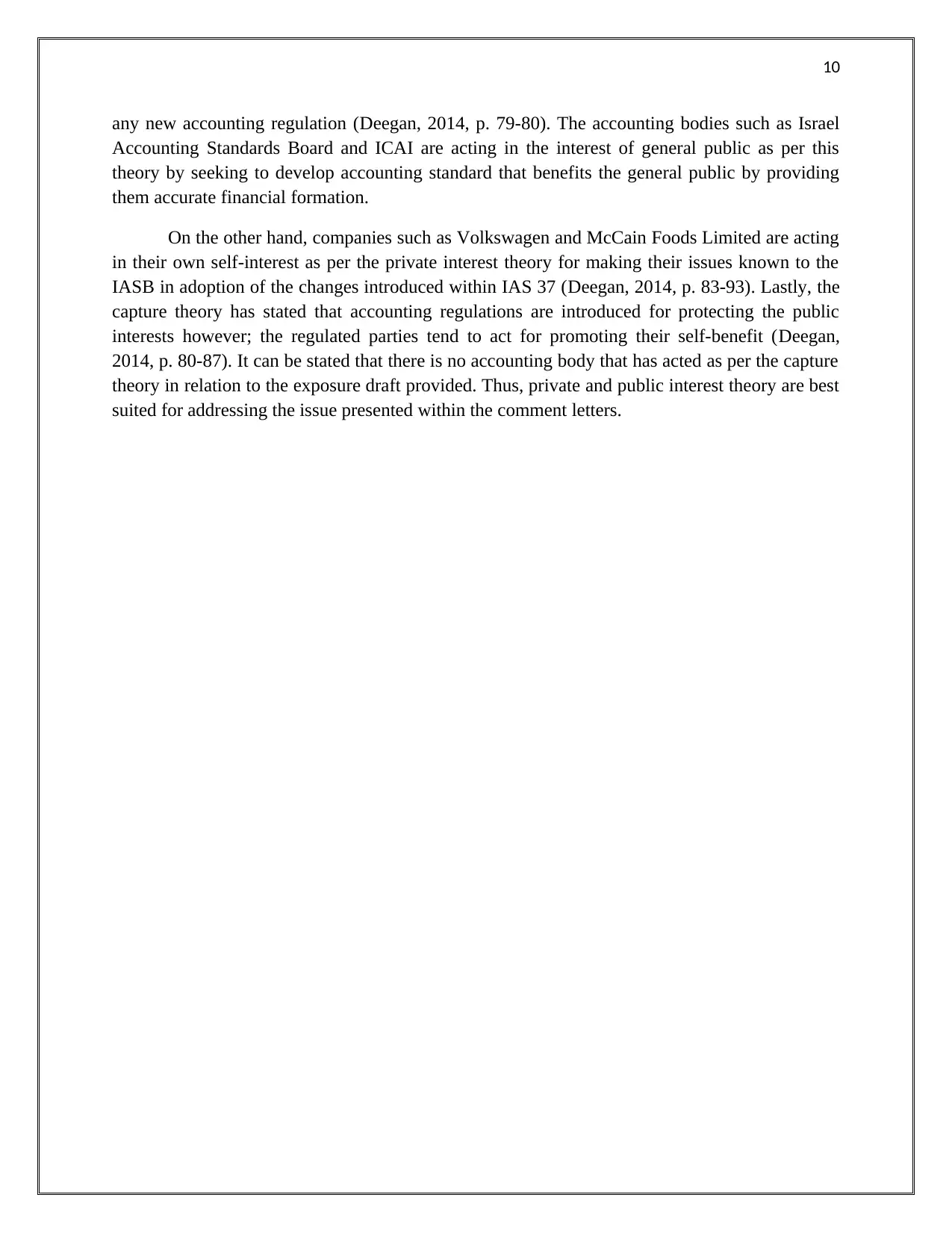
10
any new accounting regulation (Deegan, 2014, p. 79-80). The accounting bodies such as Israel
Accounting Standards Board and ICAI are acting in the interest of general public as per this
theory by seeking to develop accounting standard that benefits the general public by providing
them accurate financial formation.
On the other hand, companies such as Volkswagen and McCain Foods Limited are acting
in their own self-interest as per the private interest theory for making their issues known to the
IASB in adoption of the changes introduced within IAS 37 (Deegan, 2014, p. 83-93). Lastly, the
capture theory has stated that accounting regulations are introduced for protecting the public
interests however; the regulated parties tend to act for promoting their self-benefit (Deegan,
2014, p. 80-87). It can be stated that there is no accounting body that has acted as per the capture
theory in relation to the exposure draft provided. Thus, private and public interest theory are best
suited for addressing the issue presented within the comment letters.
any new accounting regulation (Deegan, 2014, p. 79-80). The accounting bodies such as Israel
Accounting Standards Board and ICAI are acting in the interest of general public as per this
theory by seeking to develop accounting standard that benefits the general public by providing
them accurate financial formation.
On the other hand, companies such as Volkswagen and McCain Foods Limited are acting
in their own self-interest as per the private interest theory for making their issues known to the
IASB in adoption of the changes introduced within IAS 37 (Deegan, 2014, p. 83-93). Lastly, the
capture theory has stated that accounting regulations are introduced for protecting the public
interests however; the regulated parties tend to act for promoting their self-benefit (Deegan,
2014, p. 80-87). It can be stated that there is no accounting body that has acted as per the capture
theory in relation to the exposure draft provided. Thus, private and public interest theory are best
suited for addressing the issue presented within the comment letters.
Paraphrase This Document
Need a fresh take? Get an instant paraphrase of this document with our AI Paraphraser
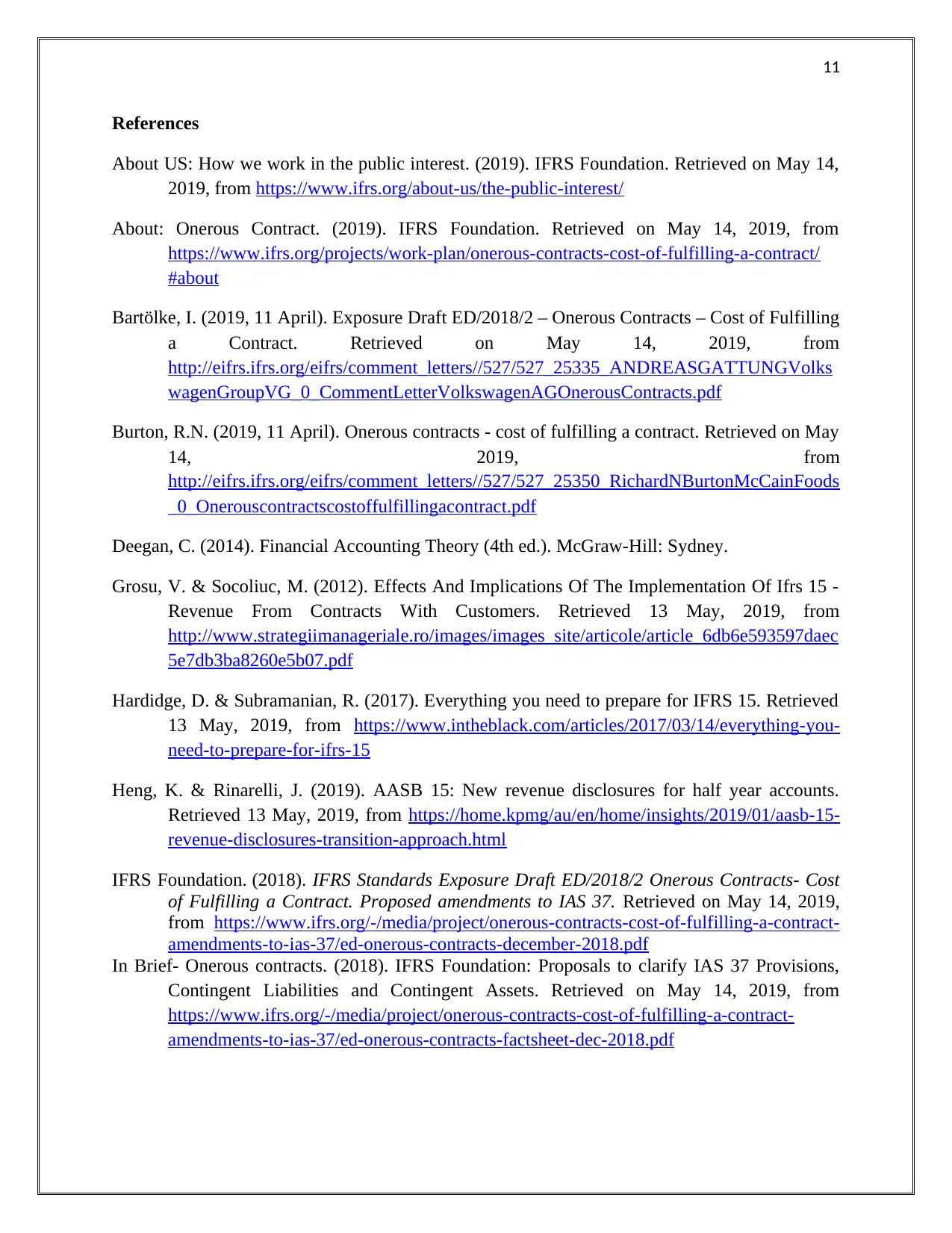
11
References
About US: How we work in the public interest. (2019). IFRS Foundation. Retrieved on May 14,
2019, from https://www.ifrs.org/about-us/the-public-interest/
About: Onerous Contract. (2019). IFRS Foundation. Retrieved on May 14, 2019, from
https://www.ifrs.org/projects/work-plan/onerous-contracts-cost-of-fulfilling-a-contract/
#about
Bartölke, I. (2019, 11 April). Exposure Draft ED/2018/2 – Onerous Contracts – Cost of Fulfilling
a Contract. Retrieved on May 14, 2019, from
http://eifrs.ifrs.org/eifrs/comment_letters//527/527_25335_ANDREASGATTUNGVolks
wagenGroupVG_0_CommentLetterVolkswagenAGOnerousContracts.pdf
Burton, R.N. (2019, 11 April). Onerous contracts - cost of fulfilling a contract. Retrieved on May
14, 2019, from
http://eifrs.ifrs.org/eifrs/comment_letters//527/527_25350_RichardNBurtonMcCainFoods
_0_Onerouscontractscostoffulfillingacontract.pdf
Deegan, C. (2014). Financial Accounting Theory (4th ed.). McGraw-Hill: Sydney.
Grosu, V. & Socoliuc, M. (2012). Effects And Implications Of The Implementation Of Ifrs 15 -
Revenue From Contracts With Customers. Retrieved 13 May, 2019, from
http://www.strategiimanageriale.ro/images/images_site/articole/article_6db6e593597daec
5e7db3ba8260e5b07.pdf
Hardidge, D. & Subramanian, R. (2017). Everything you need to prepare for IFRS 15. Retrieved
13 May, 2019, from https://www.intheblack.com/articles/2017/03/14/everything-you-
need-to-prepare-for-ifrs-15
Heng, K. & Rinarelli, J. (2019). AASB 15: New revenue disclosures for half year accounts.
Retrieved 13 May, 2019, from https://home.kpmg/au/en/home/insights/2019/01/aasb-15-
revenue-disclosures-transition-approach.html
IFRS Foundation. (2018). IFRS Standards Exposure Draft ED/2018/2 Onerous Contracts- Cost
of Fulfilling a Contract. Proposed amendments to IAS 37. Retrieved on May 14, 2019,
from https://www.ifrs.org/-/media/project/onerous-contracts-cost-of-fulfilling-a-contract-
amendments-to-ias-37/ed-onerous-contracts-december-2018.pdf
In Brief- Onerous contracts. (2018). IFRS Foundation: Proposals to clarify IAS 37 Provisions,
Contingent Liabilities and Contingent Assets. Retrieved on May 14, 2019, from
https://www.ifrs.org/-/media/project/onerous-contracts-cost-of-fulfilling-a-contract-
amendments-to-ias-37/ed-onerous-contracts-factsheet-dec-2018.pdf
References
About US: How we work in the public interest. (2019). IFRS Foundation. Retrieved on May 14,
2019, from https://www.ifrs.org/about-us/the-public-interest/
About: Onerous Contract. (2019). IFRS Foundation. Retrieved on May 14, 2019, from
https://www.ifrs.org/projects/work-plan/onerous-contracts-cost-of-fulfilling-a-contract/
#about
Bartölke, I. (2019, 11 April). Exposure Draft ED/2018/2 – Onerous Contracts – Cost of Fulfilling
a Contract. Retrieved on May 14, 2019, from
http://eifrs.ifrs.org/eifrs/comment_letters//527/527_25335_ANDREASGATTUNGVolks
wagenGroupVG_0_CommentLetterVolkswagenAGOnerousContracts.pdf
Burton, R.N. (2019, 11 April). Onerous contracts - cost of fulfilling a contract. Retrieved on May
14, 2019, from
http://eifrs.ifrs.org/eifrs/comment_letters//527/527_25350_RichardNBurtonMcCainFoods
_0_Onerouscontractscostoffulfillingacontract.pdf
Deegan, C. (2014). Financial Accounting Theory (4th ed.). McGraw-Hill: Sydney.
Grosu, V. & Socoliuc, M. (2012). Effects And Implications Of The Implementation Of Ifrs 15 -
Revenue From Contracts With Customers. Retrieved 13 May, 2019, from
http://www.strategiimanageriale.ro/images/images_site/articole/article_6db6e593597daec
5e7db3ba8260e5b07.pdf
Hardidge, D. & Subramanian, R. (2017). Everything you need to prepare for IFRS 15. Retrieved
13 May, 2019, from https://www.intheblack.com/articles/2017/03/14/everything-you-
need-to-prepare-for-ifrs-15
Heng, K. & Rinarelli, J. (2019). AASB 15: New revenue disclosures for half year accounts.
Retrieved 13 May, 2019, from https://home.kpmg/au/en/home/insights/2019/01/aasb-15-
revenue-disclosures-transition-approach.html
IFRS Foundation. (2018). IFRS Standards Exposure Draft ED/2018/2 Onerous Contracts- Cost
of Fulfilling a Contract. Proposed amendments to IAS 37. Retrieved on May 14, 2019,
from https://www.ifrs.org/-/media/project/onerous-contracts-cost-of-fulfilling-a-contract-
amendments-to-ias-37/ed-onerous-contracts-december-2018.pdf
In Brief- Onerous contracts. (2018). IFRS Foundation: Proposals to clarify IAS 37 Provisions,
Contingent Liabilities and Contingent Assets. Retrieved on May 14, 2019, from
https://www.ifrs.org/-/media/project/onerous-contracts-cost-of-fulfilling-a-contract-
amendments-to-ias-37/ed-onerous-contracts-factsheet-dec-2018.pdf
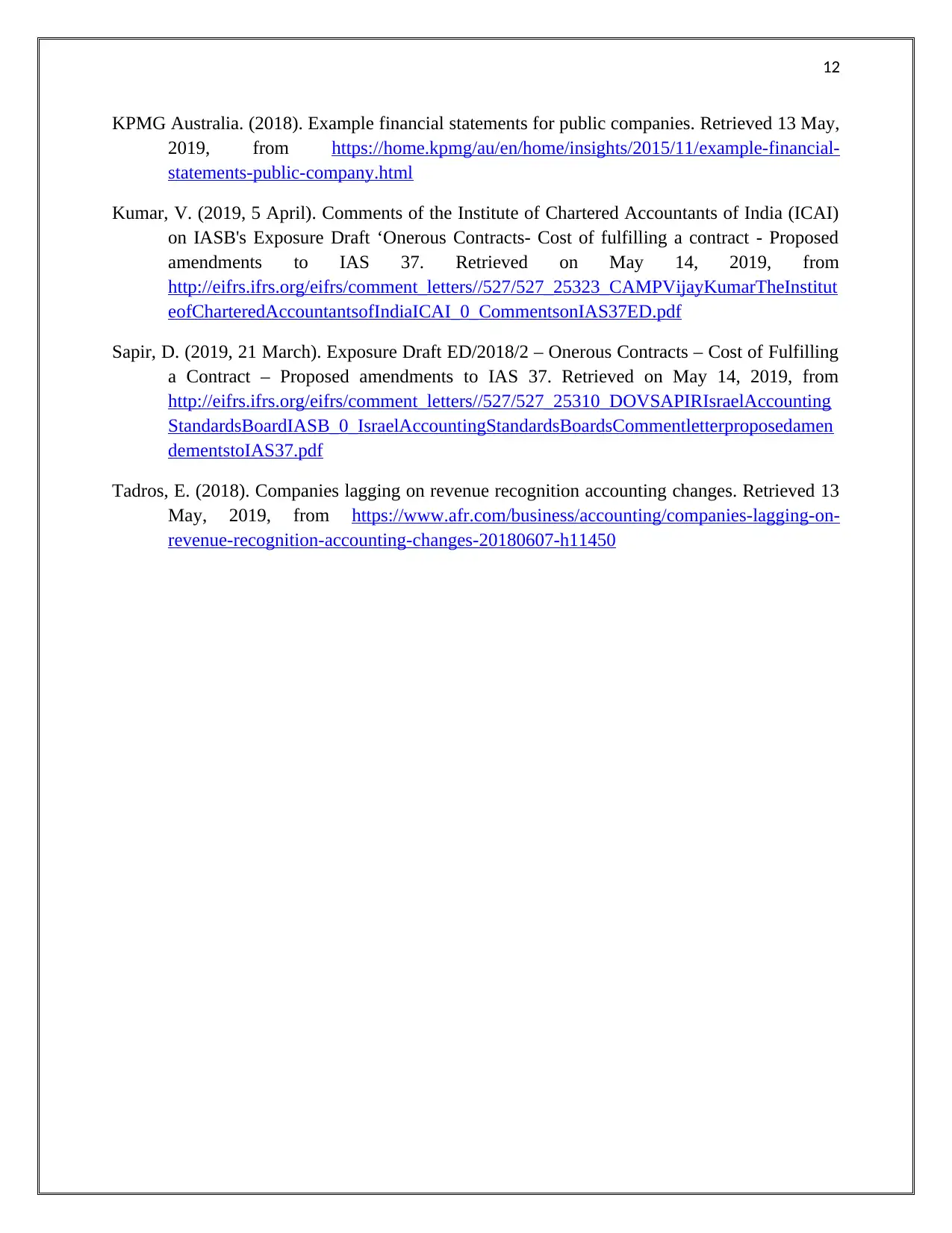
12
KPMG Australia. (2018). Example financial statements for public companies. Retrieved 13 May,
2019, from https://home.kpmg/au/en/home/insights/2015/11/example-financial-
statements-public-company.html
Kumar, V. (2019, 5 April). Comments of the Institute of Chartered Accountants of India (ICAI)
on IASB's Exposure Draft ‘Onerous Contracts- Cost of fulfilling a contract - Proposed
amendments to IAS 37. Retrieved on May 14, 2019, from
http://eifrs.ifrs.org/eifrs/comment_letters//527/527_25323_CAMPVijayKumarTheInstitut
eofCharteredAccountantsofIndiaICAI_0_CommentsonIAS37ED.pdf
Sapir, D. (2019, 21 March). Exposure Draft ED/2018/2 – Onerous Contracts – Cost of Fulfilling
a Contract – Proposed amendments to IAS 37. Retrieved on May 14, 2019, from
http://eifrs.ifrs.org/eifrs/comment_letters//527/527_25310_DOVSAPIRIsraelAccounting
StandardsBoardIASB_0_IsraelAccountingStandardsBoardsCommentletterproposedamen
dementstoIAS37.pdf
Tadros, E. (2018). Companies lagging on revenue recognition accounting changes. Retrieved 13
May, 2019, from https://www.afr.com/business/accounting/companies-lagging-on-
revenue-recognition-accounting-changes-20180607-h11450
KPMG Australia. (2018). Example financial statements for public companies. Retrieved 13 May,
2019, from https://home.kpmg/au/en/home/insights/2015/11/example-financial-
statements-public-company.html
Kumar, V. (2019, 5 April). Comments of the Institute of Chartered Accountants of India (ICAI)
on IASB's Exposure Draft ‘Onerous Contracts- Cost of fulfilling a contract - Proposed
amendments to IAS 37. Retrieved on May 14, 2019, from
http://eifrs.ifrs.org/eifrs/comment_letters//527/527_25323_CAMPVijayKumarTheInstitut
eofCharteredAccountantsofIndiaICAI_0_CommentsonIAS37ED.pdf
Sapir, D. (2019, 21 March). Exposure Draft ED/2018/2 – Onerous Contracts – Cost of Fulfilling
a Contract – Proposed amendments to IAS 37. Retrieved on May 14, 2019, from
http://eifrs.ifrs.org/eifrs/comment_letters//527/527_25310_DOVSAPIRIsraelAccounting
StandardsBoardIASB_0_IsraelAccountingStandardsBoardsCommentletterproposedamen
dementstoIAS37.pdf
Tadros, E. (2018). Companies lagging on revenue recognition accounting changes. Retrieved 13
May, 2019, from https://www.afr.com/business/accounting/companies-lagging-on-
revenue-recognition-accounting-changes-20180607-h11450
⊘ This is a preview!⊘
Do you want full access?
Subscribe today to unlock all pages.

Trusted by 1+ million students worldwide
1 out of 12
Related Documents
Your All-in-One AI-Powered Toolkit for Academic Success.
+13062052269
info@desklib.com
Available 24*7 on WhatsApp / Email
![[object Object]](/_next/static/media/star-bottom.7253800d.svg)
Unlock your academic potential
Copyright © 2020–2025 A2Z Services. All Rights Reserved. Developed and managed by ZUCOL.





